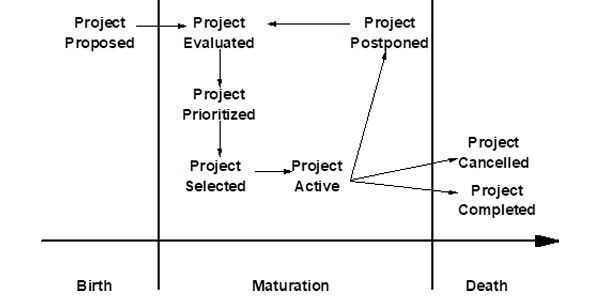OUTSIDE THE BOX Forum: Project Birth, Maturation and Death Process, Part 2 of 2
The project enters the maturation process on the first day it becomes an active project.
The successful conduct of a complex project is fraught with all sorts of challenges.

Project Active
A selected project is active if it has received its funding authorization and is open for work. At this stage, the PM is authorized to proceed with the recruiting and assignment of team members, to prepare the final work schedule, and other activities associated with launching the project.
In a complex project environment the SMT needs to maintain control while being flexible and adaptive at the same time. Here are my suggestions for your consideration:
Understand the deliverable schedule and expect exception reports only. For myself reports such as
- Everything is going according to plan.
- There are some minor variances from plan but I have a get well plan in place that will bring the plan in compliance by the next report date. The details are attached for your information.
- There are major variances from plan and I need help implementing a corrective action plan. The details are attached for your action.
- The project is heading for failure and I do not have the authority or knowledge to restore the project to plan. The details are attached for your intervention.
Project Evaluated
The Evaluation Phase consists of determining which portfolio or portfolios the project is most closely aligned with. Three outcomes are possible from this evaluation:
- The project is not aligned and is rejected out of hand.
- The project is not aligned but revision and resubmission recommended.
- The project is aligned.
Alignment is often a quantitative measure. Once the project is determined to be aligned the proposing parties should begin preparing a detailed plan. The plan will contain information like time, cost, and resource requirements that will help the portfolio manager make a final determination regarding the project support that will be needed from the portfolio.
Alignment is a complex task. The first decision the SMT needs to make is how to define the alignment process. Will you use a quantitative or qualitative metric? I’ll defer that discussion to Chapter 9: An Agile Portfolio Strategy. The next decision is alignment with respect to what – a specific portfolio, several portfolios, one or more strategic objectives? That is also discussed in Chapter 9 and a few models suggested.
Project Prioritized
All proposed projects for the portfolio will be ranked along with other projects proposed for the same portfolio. This is the final stage before the project is selected for the portfolio. If it is high enough in priority, it will be funded and included in the portfolio.
The big question for the SMT is what criterion should be used for developing that prioritized list? Among the quantitative metrics business value is the most popular choice in the complex project world although risk and return on investment have also been used.
While you could force one measure on all project proposals that might be too restrictive and force invalid conversions of success measures to a single metric, like bottom line dollars. So allowing any one of the three metrics defined in IRACIS to be used, the problem reduces to comparing projects across all three measures of business value.
Among the qualitative measures a variety of rules such as MoSCoW are in common use:
M = must do
S = should do
C = could do
W = will not do now
Variations of A, B, and C or 1, 2, and 3 are also common. I personally prefer and exclusively use MoSCoW. The major reason is that each category contains a descriptor.
[widget id=”custom_html-68″]
Project Selected
This is a temporary classification and assuming approval of the portfolio, this project will be supported. That support may come in the form of less time, money, and resources than were requested. In such cases a revised project plan and expected business value will be prepared.
It goes without saying that the request for money, time, and staff will always exceed what is available. To think otherwise is pure fantasy. The SMT is responsible for defining the model that drives how these selection decisions will be made. For example, for a given portfolio you could fully fund the first ten of the fifteen projects selected for that portfolio or you could partially fund the first twelve. Which decision will you take? Is there a business rule here or will the decision be subjective? And don’t forget that complex projects will only succeed in a creative environment. Does that creativity encompass the selection criteria? I would argue for your making room for some speculation but being heavy handed on accountability.
As a portfolio manager there are some traps awaiting you. You can easily force a PM into a no-win situation by maintaining the originally proposed deliverables but in less time, for less money or with fewer resources. Many PMs want their projects supported and will often agree to compromises that cannot be realistically attained. Be careful that you don’t force them into such positions. Once the level of support has been awarded require the PM to finalize the project plan and deliverables in line with the support provided and then negotiate from that position to a realistic closure. Now the project team can be held accountable for the results they agreed to deliver. If you base individual performance reviews on project performance, you will have created a motivating environment.
As the sponsoring executive you are responsible for achieving expected business value. You sold the expected business value of the project to your SMT colleagues and they deferred to your judgment. The project team is responsible for completing the project as defined by your office. The project team is not responsible for the business value. They may contribute to increased business value but the sponsor is responsible for achieving the expected business value.
Project Death Process
There are three ways that the project can move through the death process. It can be postponed, canceled or completed.
Project Postponed
An active project is postponed if its staff resources have been temporarily removed. Such projects must return to the pool of prioritized projects and be selected and its staff resources restored. The resources allocated to a postponed project are returned to the staffing category from which they originated to be reallocated to the next project in the queue of that project category.
Postponed indefinitely
The problem situation or business opportunity is no longer what it was when the project was first proposed. Unless that situation changes the project will die a slow death.
Paused
A project can be paused for some number of cycles due to a temporary condition and then resumed when the condition is no longer in play. These conditions include:
- Higher priority projects require team resources for a few cycles for completion.
- There is a temporary loss of resources to the portfolio.
Project Cancelled
An active project is canceled if it has failed to demonstrate planned progress toward its successful completion. Depending on the stage in which the project was cancelled, there may be unspent resources. If so, they are returned to the resource pool from which they originated. Those resources then become available for the next project in the prioritized queue of projects being held pending funding for that portfolio.
Project Completed
A project is completed if it has met all of its objectives and delivered acceptable business value. Even if it hasn’t met all of its objectives the decision may be to call the current solution acceptable and hence the project complete. Recall that the complex project environment is one where the final solution is not known at project launch and the solution attained may compromise some of the deliverables and hence delivered business value may be less than planned business value but yet acceptable to the SMT.
Putting It All Together
Every organization needs to define its own version of this birth and death process. Having done that the organization and the SMT can track the number of projects in each category. This is especially important in establishing the contents of each portfolio. Of specific interest will be the Project Prioritization category and the staffing of selected projects. Prioritization includes new projects, continuing projects, and postponed projects. Defining the rules for prioritization is not as easy as you might think. The three categories of projects are to be prioritized in a single list and they are very different types of projects.










